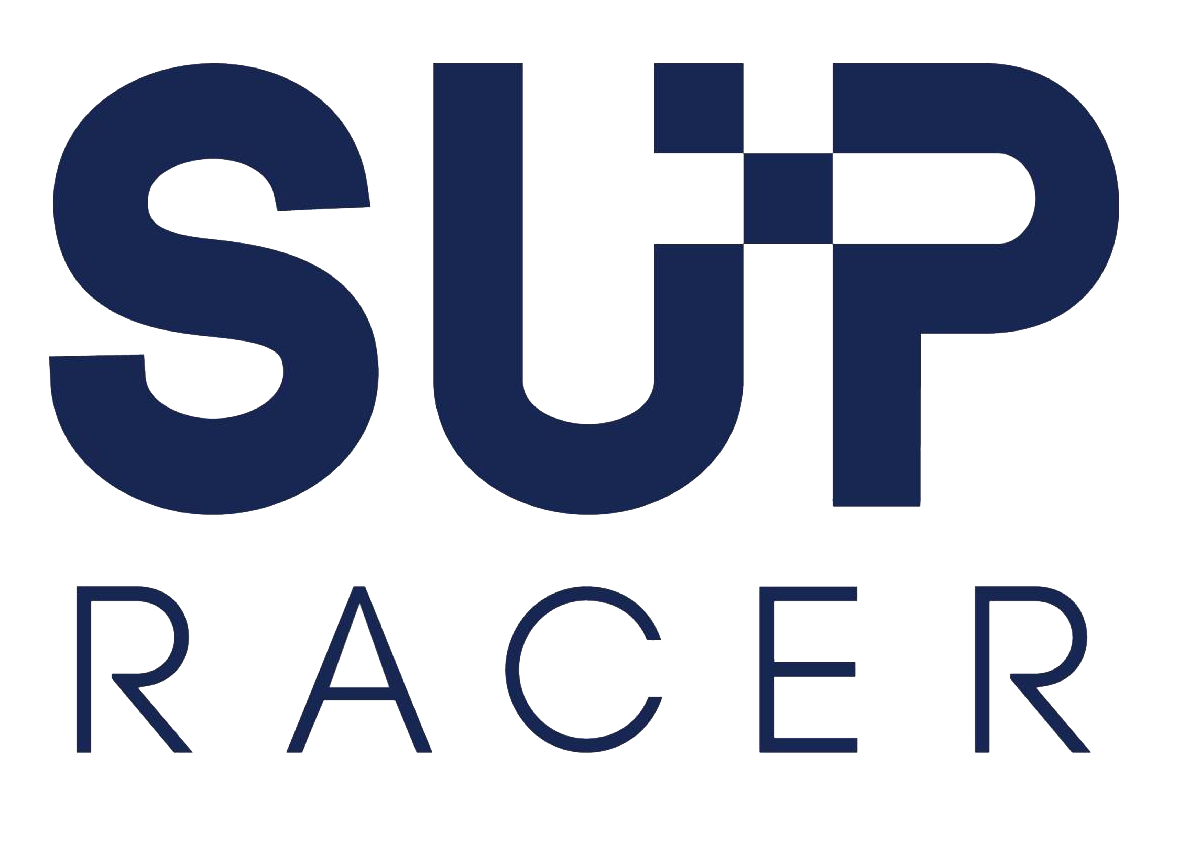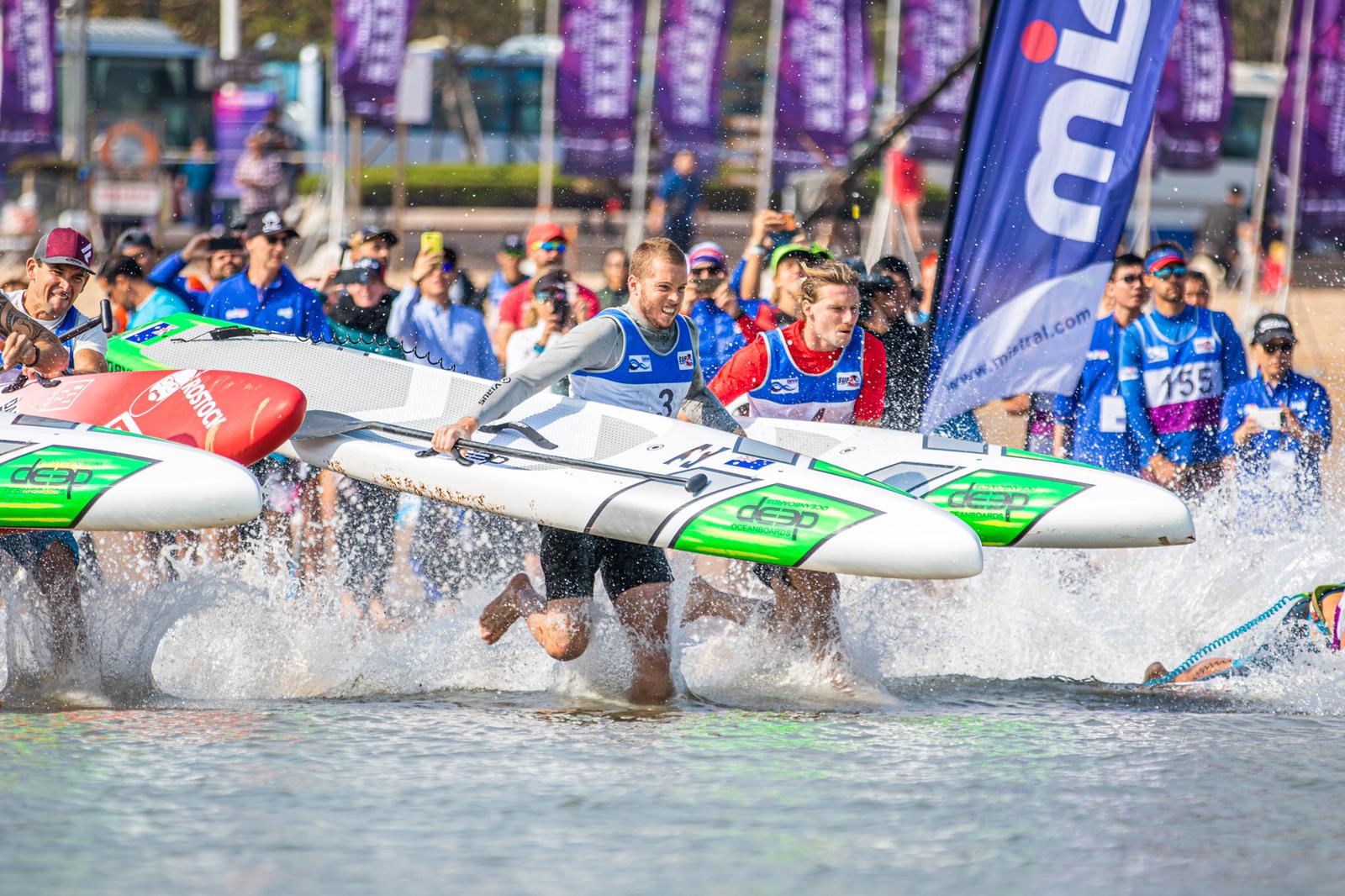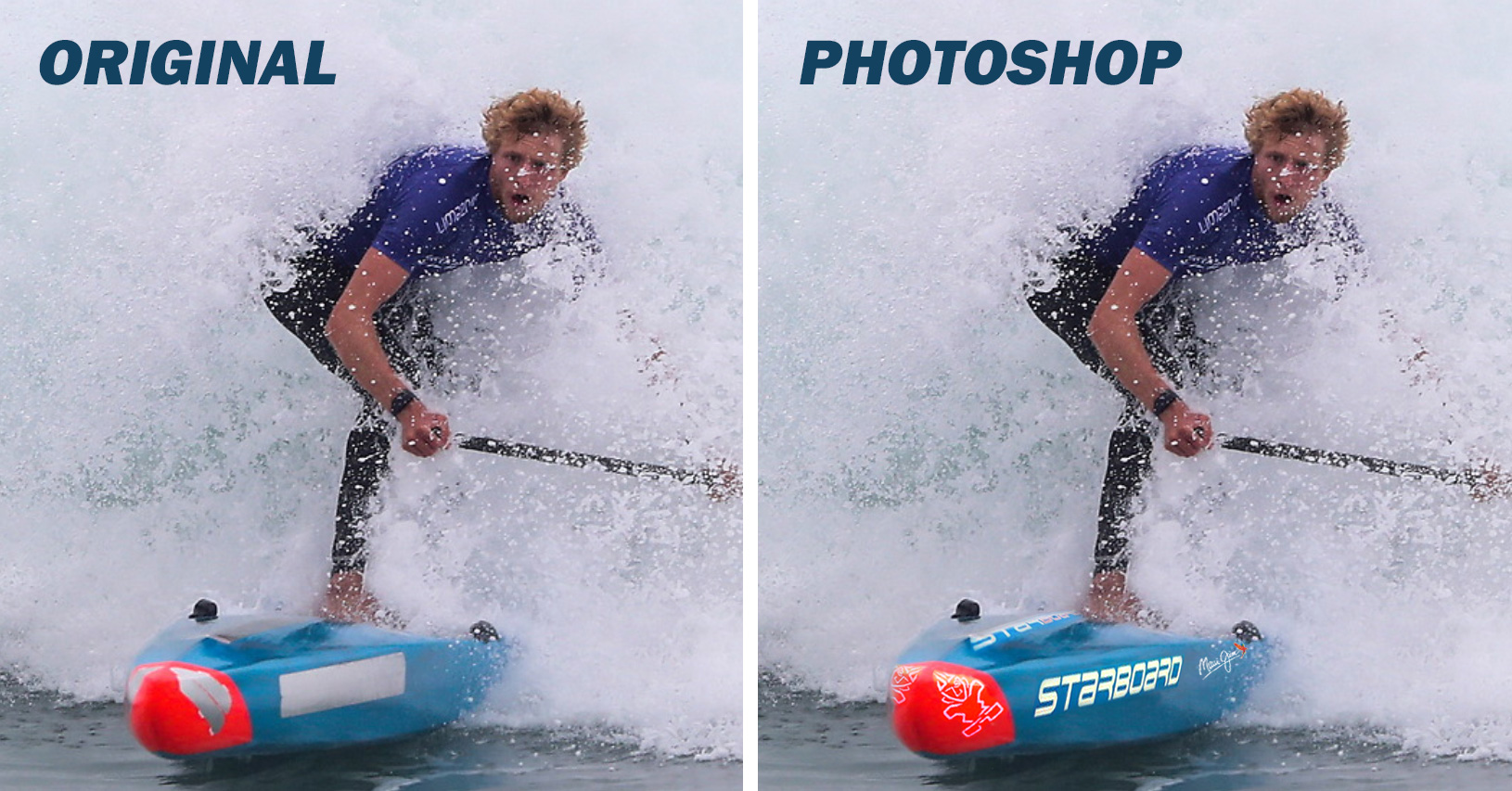
The Olympic Sticker Debate: Why did Pan-Am paddlers have to hide their sponsors?
The Pan American Games were held in Peru this week. The event is known as the “Olympics of the Americas” and welcomed stand up paddlers for the first time in its 68-year history. The performances of Connor Baxter and Brazil’s Lena Ribeiro, the inaugural gold medalists in the Pan-Am Games surf race, presented SUP with a historic moment.
But while the presence of paddleboarding in an Olympic-style event is positive, one thing about the race seemed a little odd:
“Why are the sponsors all covered up?”
Several people raised an eyebrow and asked this question after I posted a shot of Connor surfing his way to victory on Saturday.
Curious, I decided to dig a little deeper, and the answer is equal parts fascinating and disturbing. It offers a glimpse into the business-fueled world of the Olympic movement where the interests of athletes are often secondary to those of corporate partners.
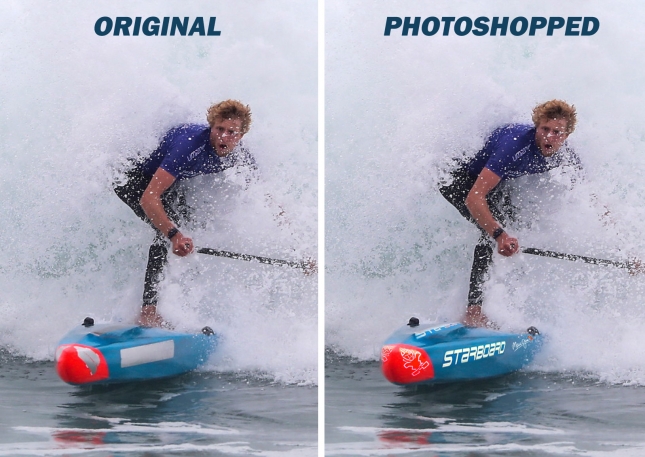
On the left is the original photo of Connor Baxter on his way to winning gold for Team USA (captured by the talented photographer @marcellozambrana).
On the right is the version I photoshopped to make Connor’s board look more like it’s supposed to.
Connor, like every other athlete in the race, had to hide his sponsors before he was allowed to compete. He peeled off the stickers of Maui Jim, Salt Life and a few other brands that support him, and he covered the irremovable Starboard decals with silver tape.
The reason why is simple enough: major sporting events including the Pan-Am Games and Olympic Games protect their corporate partners by aggressively blocking “free advertising” for outside sponsors. If a brand isn’t an official event partner, you’re not allowed to show their logo or even mention their name, even if it’s one of your personal sponsors.
On the surface it makes sense when you consider that corporate partners help fund these expensive events. But the closer you look, the more you realise it also hurts the athletes’ ability to earn a living during the most critical times of their careers.
And the restrictions go far beyond stickers…
Considering there’s zero prize money and that many national sporting federations (especially surfing ones) are poorly funded, personal sponsors are often the ones enabling athletes to compete in the first place. Is a little bit of exposure too much to ask in return?
There was some leniency in the Pan-Ams: athletes were allowed a logo on their equipment up to 60cm² in size. But that’s still way smaller than most sponsors’ standard branding. For context: The palm of your hand is about 80cm².
The rule also states that only one of these mini stickers is allowed per piece of equipment, which doesn’t really help athletes like Connor that have half a dozen sponsors.
Quickblade, for example, created special stickers for their athletes such as Itzel Delgado, however even the iconic ‘QB’ is barely recognizable in the photo below (and you’ll notice that most of the Infinity branding is missing from Itzel’s board as well).
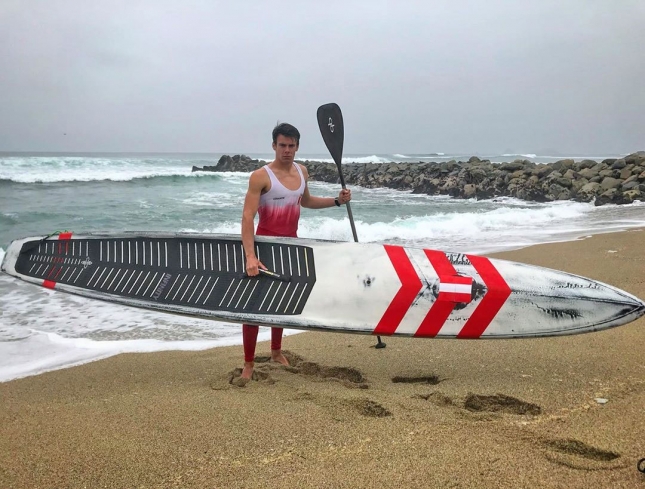
Itzel Delgado earned the host nation of Peru a bronze medal on Saturday (photo via @itzel_delgado1)
Stand up paddling is hardly the first sport to encounter this. It’s a very common and very contentious issue in the Olympic world. Articles appear routinely every four years.
Nike is notorious for obscuring the shoes of rival-branded athletes during the American basketball team photoshoot. Michaeal Phelps had to cover the “Beats” logo on his headphones with American flag stickers. Samsung even (allegedly) asked athletes to cover up their iPhone logos during the Winter Olympics.
It’s a two-sided issue of course: If corporate partners don’t feel their investment is protected they may withdraw their sponsorship, which jeopardises the event. Tactics such as “ambush marketing” are a big concern for major sporting events, and you could argue that 14ft race boards could potentially become 14ft billboards if it was a free-for-all. But there’s got to be some middle ground.
And while some would argue the privilege of representing your country is enough, or that a gold medal can translate into other sponsorship opportunities post-event, why are athletes the only ones not allowed to earn anything during the Games?
The corporate partners, broadcasters, tourism, lobbyists, sporting federations, the event organisers and pretty much everyone else is allowed to bank on these big events. It’s only the athletes that can’t act in a commercial manner — which is ridiculous considering they’re the stars of the show.
It’s reminiscent of the billion-dollar NCAA basketball system in America whose own founder has likened it to modern-day slavery because the only ones not allowed to earn money are the players themselves.
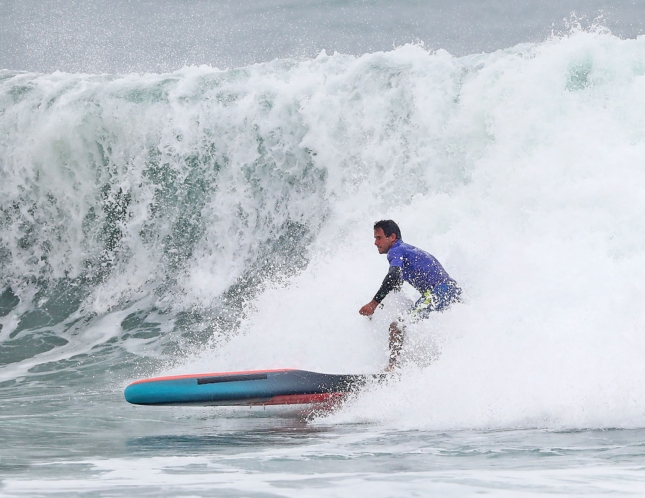
Vinni Martins on the wave of the day (notice the blacked-out ‘JP Australia’ logo on the side of his board) photo: @marcellozambrana
But the most intriguing part of this story is that it goes so far beyond logos: Competitors are banned from even tagging their own sponsors on Instagram.
The notorious ‘Rule #40’ of the IOC (International Olympic Committee) charter is aggressively policed during the Olympics, and while I’ve heard it wasn’t enforced quite as strictly in Peru, the same rule applies to the Pan American Games.
Rule 40 prohibits athletes (as well as coaches and support staff) from even mentioning their sponsors on social media before, during and after the Games, let alone displaying their sponsor logos during competition.
There have been countless athlete protests and several legal challenges against Rule 40 (only the German athletes have had any success in the courts), while the IOC has vaguely promised to reconsider the rule’s wording. But the rule still stands, because the Olympics are big business.
Consequences for breaking Rule #40 can range from financial penalties (how ironic) all the way up to full disqualification from competition.
Disqualification.
Forget about doping and corruption, clearly the real danger facing modern sport is Instagram…
For more background on this contentious issue see: “With ‘Rule 40,’ Greedy IOC Shows It Cares More About Its Sponsors Than Olympic Athletes”
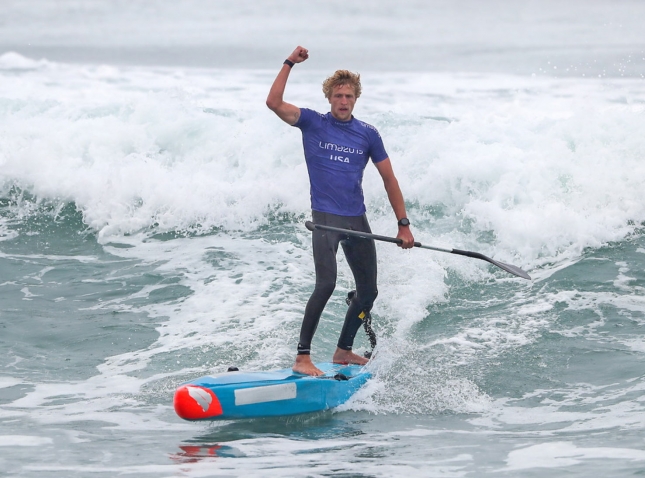
Connor Baxter claimed gold but wasn’t allowed to give his sponsors any love (credit: @marcellozambrana)
Ironically, all of this actually creates what’s known as the “Streisand Effect” whereby the desire to hide something inadvertently gives it more attention. I certainly wouldn’t have done this post about Starboard’s All-Star race board (2020 range just released, FYI) if Connor wasn’t forced to hide the logo.
Also, anyone who knows anything about SUP knows that a blue board with a bright red nose is a Starboard. Funnily enough, Pan-Am rules actually prohibit sponsor-specific “color schemes” and designs on equipment, though fortunately organisers in Peru stopped short of making all the paddlers paint their boards white.
None of this really matters beyond the Pan-Ams, of course, because SUP isn’t actually in the Olympics (and it may never be — we’re not even sure which federation is “in charge”). But I think it’s a fascinating topic that’s worth debating, because if we ever do reach the sporting world’s highest stage we should be aware of the cold, corporate reality that is the Olympic Games.
But whatever your take on this — pro-corporate or pro-athlete — I think we can all agree it looks utterly ridiculous when paddlers have to cover their board in silver tape. The Pan-Ams were in many ways a historic moment for SUP, and it should always be an honour to represent your country, but surely there’s a better way to push the sport forward.
Thoughts? I’d love to hear what you think — leave a comment on the original Facebook thread.
